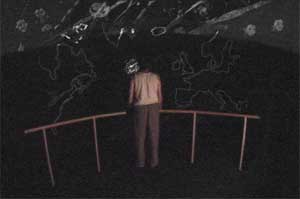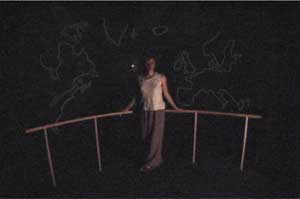view video
Harvard University Fellowship Project
Inga Frick and I worked together on an interactive video installation as fellows in residence at Harvard University. The project was developed in conjunction with BioID(HumanScan), a German company specializing in face recognition software.
An interactive artwork in which things seen in the corner of your eye, disappear when you turn around to look at them.
On entering a darkened room the viewer is drawn to move into an illuminated circle in front of a curved railing reminiscent of a ship’s prow. As the lighting dims one distinguishes a “porthole” in the darkness ahead, through which are seen images that reference navigation, mapping and ocean travel. When the viewer’s vision is directed toward the front, a projection starts up behind (this is accomplished using face recognition software — see Collaboration with Dialog Communication Systems). Colorful moving images are projected on scrims behind the viewer and reflected onto the walls and ceiling of the installation, hence entering the viewer’s peripheral vision. However, as the viewer turns around to see what is happening behind them, the projected images immediately fade away. The viewer glimpses the embers of an image – enough to tantalize but not to decipher. The rear projections reappear again only after the viewer turns forward. Available only peripherally, the elusive and sensuous projections behind the viewer slip from view when directly confronted, perhaps evoking longing for what is hopelessly lost or unattainable. In disappearing their promised richness becomes ever more desirable. One is left on the prow, looking forward, positioning oneself, scanning, narrowing in, searching, yet yearning for what’s behind. The mind seems split between directed attention and those more expanded, free-floating arenas of mentation which are ever present, but experienced fleetingly, obliquely, as they flee from directed attention. Scrutiny brings a narrowing of vision, ineluctably backgrounding that which is not being regarded. Science, among other disciplines, attains ever more satisfying answers to questions, but only, of course, to those questions that are posed. Much lies peripheral to the scope of the attentive gaze.
In order for this installation to be effective it was essential that the rear (peripheral) projections appeared and disappeared seamlessly in reaction to the viewers head movements. In the process of researching this problem, we communicated by email with Robert Frischholz, Vice President of Research and Development at BioID, a leading manufacturer of face recognition software. On hearing of the projects he was warmly enthusiastic and supportive and within a short time the research team modified BioID software to work with our installation. This interdisciplinary, cross-cultural collaboration was one of the most fun and satisfying parts of the project.
How it works:
Images from a small video camera located at the front of the installation, are constantly processed by the BioID software. When a face is detected (that is, when the viewer is facing forward), a signal is sent to an EZIO board (from Michael Rodemer, U. Michigan) which triggers the illumination of the rear video projections. When the face is no longer detected (that is, when the viewer turns around to look behind him), the projections are triggered to fade. Ralph Bunker (Gillian’s husband), wrote the Lingo code for Macromedia’s Director, which mediates the communication between the face recognition software and the EZIO board. The wonderfully creative people we worked with at BioID have now started a new company, HumanScan.

